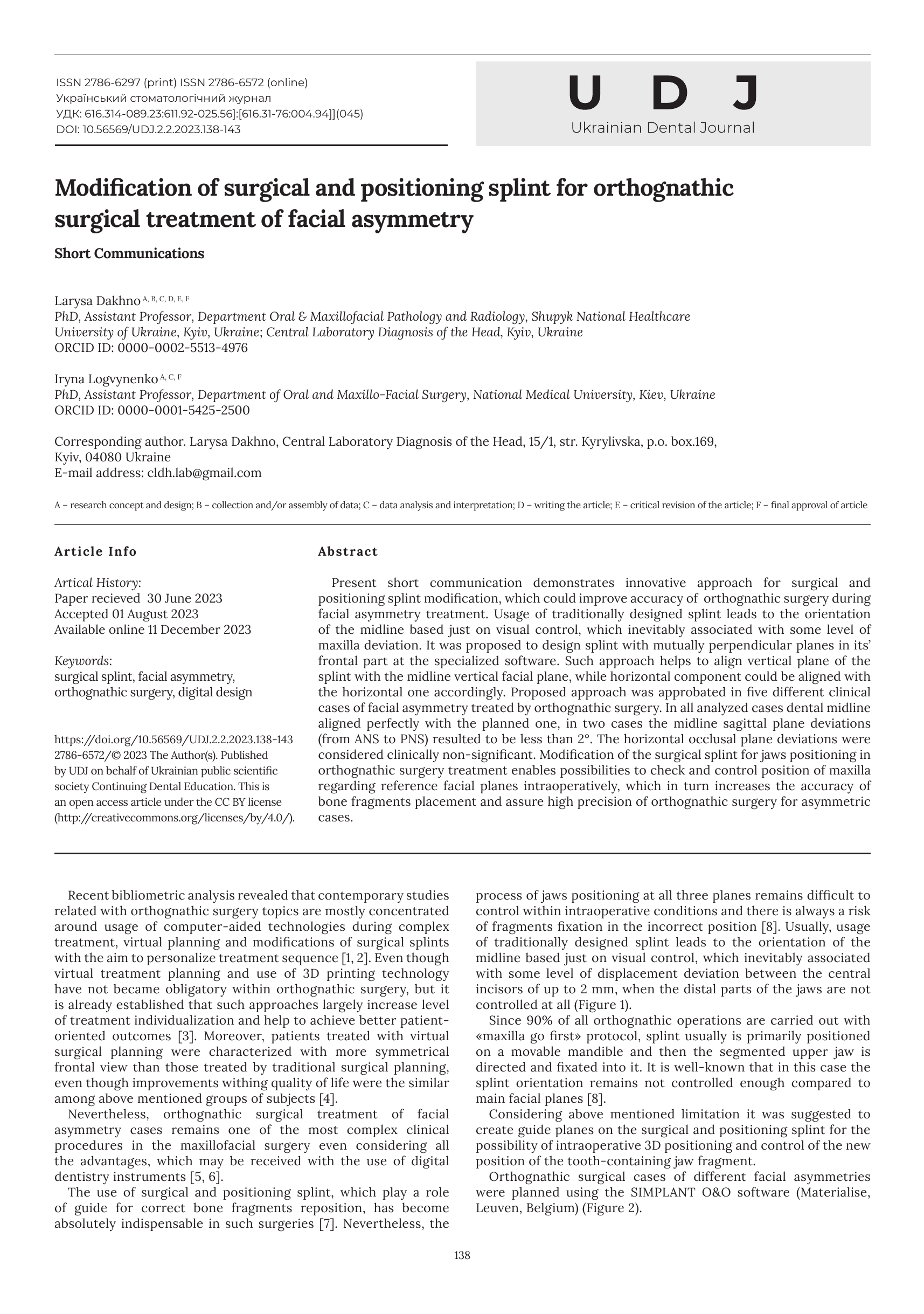Modification of surgical and positioning splint for orthognathic surgical treatment of facial asymmetry
Short Communications
DOI:
https://doi.org/10.56569/UDJ.2.2.2023.138-143Keywords:
surgical splint, facial asymmetry, computer-assisted design, orthognathic surgeryAbstract
Present short communication demonstrates innovative approach for surgical and positioning splint modification, which could improve accuracy of orthognathic surgery during facial asymmetry treatment. Usage of traditionally designed splint leads to the orientation of the midline based just on visual control, which inevitably associated with some level of maxilla deviation. It was proposed to design splint with mutually perpendicular planes in its’ frontal part at the specialized software. Such approach helps to align vertical plane of the splint with the midline vertical facial plane, while horizontal component could be aligned with the horizontal one accordingly. Proposed approach was approbated in five different clinical cases of facial asymmetry treated by orthognathic surgery. In all analyzed cases dental midline aligned perfectly with the planned one, in two cases the midline sagittal plane deviations (from ANS to PNS) resulted to be less than 2°. The horizontal occlusal plane deviations were considered clinically non-significant. Modification of the surgical splint for jaws positioning in orthognathic surgery treatment enables possibilities to check and control position of maxilla regarding reference facial planes intraoperatively, which in turn increases the accuracy of bone fragments placement and assure high precision of orthognathic surgery for asymmetric cases.
References
Haas Jr OL, Becker OE, De Oliveira RB. Computer-aided planning in orthognathic surgery—systematic review. Int J Oral Maxillofac Surg. 2015;44(3):329-42. doi: https://doi.org/10.1016/j.ijom.2014.10.025
Carvalho FS, de Oliveira Barbosa DI, Torquato IF, Britto de Souza AM, Dalcico R, Chaves FN, Costa FW. The Use of surgical splints in orthognathic surgery: A bibliometric study. Indian J Plast Surg. 2021;55(01):026-30. doi: https://doi.org/10.1055/s-0041-1734570
Lee YC, Kim SG. Redefining precision and efficiency in orthognathic surgery through virtual surgical planning and 3D printing: a narrative review. Maxillofac Plas Reconstr Surg. 2023;45(1):42. doi: https://doi.org/10.1186/s40902-023-00409-2
Chen Z, Mo S, Fan X, You Y, Ye G, Zhou N. A meta-analysis and systematic review comparing the effectiveness of traditional and virtual surgical planning for orthognathic surgery: based on randomized clinical trials. J Oral Maxillofac Surg. 2021;79(2):471-e1. doi: https://doi.org/10.1016/j.joms.2020.09.005
Ajmera DH, Singh P, Leung YY, Gu M. Three-dimensional evaluation of soft-tissue response to osseous movement after orthognathic surgery in patients with facial asymmetry: A systematic review. J Craniomaxillofac Surg. 2021;49(9):763-74. doi: https://doi.org/10.1016/j.jcms.2021.04.010
Choi JW, Park H, Kwon SM, Lee JY. Surgery-first orthognathic approach for the correction of facial asymmetry. J Craniomaxillofac Surg. 2021;49(6):435-42. doi: https://doi.org/10.1016/j.jcms.2021.04.005
Sato N, Denadai R, Hung YT, Chung KH, Chou PY, Pai BC, Lo LJ, Lin HH. Single-Splint, 2-Jaw Orthognathic Surgery for Correction of Facial Asymmetry: 3-Dimensional Planning and Surgical Execution. J Craniofac Surg. 2023;online ahead of print. doi: https://doi.org/10.1097/SCS.0000000000009912
Sarkarat F, Tofighi O, Jamilian A, Fateh A, Abbaszadeh F. Are Virtually Designed 3D Printed Surgical Splints Accurate Enough for Maxillary Reposition as an Intermediate Orthognathic Surgical Guide. J Maxillofac Oral Surg. 2023;22(4):861-872. doi: https://doi.org/10.1007/s12663-023-01942-3
Alkhayer A, Piffkó J, Lippold C, Segatto E. Accuracy of virtual planning in orthognathic surgery: a systematic review. Head Face Med. 2020;16(1):1-9. doi: https://doi.org/10.1186/s13005-020-00250-2
Rückschloß T, Ristow O, Müller M, Kühle R, Zingler S, Engel M, Hoffmann J, Freudlsperger C. Accuracy of patient-specific implants and additive-manufactured surgical splints in orthognathic surgery—A three-dimensional retrospective study. J Craniomaxillofac Surg. 2019;47(6):847-53. doi: https://doi.org/10.1016/j.jcms.2019.02.011
Ng JH, Chen YA, Hsieh YJ, Yao CF, Liao YF, Chen YR. One-splint versus two-splint technique in orthognathic surgery for class III asymmetry: comparison of patient-centred outcomes. Clin Oral Investig. 2021;25:6799-811. doi: https://doi.org/10.1007/s00784-021-03967-9
Palazzo G, Ronsivalle V, Oteri G, Lo Giudice A, Toro C, Campagna P, Patini R, Bocchieri S, Bianchi A, Isola G. Comparison between additive and subtractive CAD-CAM technique to produce orthognathic surgical splints: a personalized approach. J Pers Med. 2020;10(4):273. doi: https://doi.org/10.3390/jpm10040273
Kato RM, Parizotto JD, Oliveira PH, Gonçalves JR. Artificial intelligence in orthognathic surgery–a narrative review of surgical digital tools and 3D orthognathic surgical planning. J Calif Dent Assoc. 2023;51(1):2202444. doi: https://doi.org/10.1080/19424396.2023.2202444
Liu Z, Xu C, Zhu Z, Tai Y, Liu Y, Luo E. Artificial Intelligence Splint in Orthognathic Surgery for Skeletal Class III Malocclusion: Design and Application. J Craniofac Surg. 2023;34(2):698-703. doi: https://doi.org/10.1097/SCS.0000000000009162

Downloads
Published
Issue
Section
Categories
License
Copyright (c) 2023 The Author(s)

This work is licensed under a Creative Commons Attribution 4.0 International License.








